

Wayne Schmidt's Tomato Comparison Page Growing tests to discover the sweetest cherry and the best tasting beefsteak tomatoes.
Every year I
grow several different tomato varieties and compare them to discover
which are the sweetest and best tasting. This page records what I've
learned as well as a few growing and harvesting tricks.
New for 2013! Nectar Tomato Test!
Cherry
Tomato Comparisons
My goal in growing cherry tomatoes is to grow the sweetest fruit possible. A tomato's sweetness is determined by its percent sugar and acidity. One tomato can have less sugar than a second yet taste sweeter because its acidity is lower than the second. Armed with an electronic pH (or acidity) meter and a refractometer (for measuring sugar content in Brix (percent sugar)) I grew eight different cherries and compared them to store-bought tomatoes. In most cases, dozens of each variety were tested. The numbers quoted here are averages of those tests. The sweetest tomatoes are those with the largest Brix (sugar) and highest pH (lowest acidity). Here are the results of the first season's cherry tomato comparisons:
Store-bought: Brix=4.8 pH=4.1
Matt's Wild Cherry: Brix=4.0 pH=3.9
Sun Cherry: Brix=6.5 pH=4.2
Sun Gold: Brix=6.0 pH=4.5
Super Sweet 100 Brix=6.0 pH=4.1
Sugar Snack Brix=7.4 pH=4.1
Sweet Chelsea Brix=4.7 pH=4.0
Sweet Million Brix=7.1 pH=4.1
Sweetie Brix=6.0 pH=4.0
The winners of this first test, additionally verified by taste testing, are Sun Gold and Sugar Snack. The acidity, or pH, is a nonlinear scale which means that a small increase in pH means the tomato will taste many times sweeter. Sun Gold is a winner because it's acidity is very low. Sugar Snack is outstanding because its sugar content is very high. (For comparison, unsweetened pineapple juice has a Brix of 16.2 and a pH of 3.8. Its extremely high sweetness is enough to counteract is strong acidity.)
Sun Gold wins many taste tests because in addition to being very sweet tasting it has a fruity/winey/tropical flavor that is truly unique. It's gold color also attracts fewer birds than red varieties. Both Sun Gold and Sugar Snack appear almost impervious to cracking.
The
second season's
cherry tomato comparisons had to do without PH measurements because
my electronic PH tester died. Only one new cherry tomato (Sweet Baby
Girl) was tested and it had to face off against the winners from last
season: Sun Gold and Sugar Snack. I'm happy to report Sweet Baby Girl
was a clear winner. It was much better than Sugar Snack and even
sweeter tasting than Sun Gold. Sweet Baby Girl is a red cherry tomato
and regularly tops a Brix of 8.2. This is outstanding sweet for a
tomato. Sweet Baby Girl appears to be completely crack-proof and
continues producing lots of sweet tomatoes even in 95+ degree
temperatures, though the color shifts from red to orange even if the
tomatoes are covered with white cloth to protect them from sunburn.
(Night time lows were 70 so the average temperature was a mild 82.
Locations where it remains hot around the clock may see some
reduction in productivity.) What Sun Gold still has going for it is
its uniquely delicious flavor. These two great cherry tomatoes are
going to be hard to beat.
The
third season
of cherry tomato testing introduced Sugary, an oblong cherry with a
very acidic, unsweet flavor, and Black Pearl, a tomato whose dark
ruddy color was as unattractive as its flavor was unpleasant.
2007 Season:
Even as I write this page I have Cupid cherry tomatoes sprouting to
see how they stand up to Sweet Baby Girl and Sun Gold. This season
will also attempt to answer the question about whether Sweet Baby
Girl or Sun Gold deserves to be listed as the sweetest and best
tasting cherry tomato of all.
The first Cupid cherry tomatoes from a late planting ripened on 13 October. (In my high desert location the weather this time of year still good for almost all vegetables: bright and sunny, 75-80 degree highs and 40-50 degree lows. It stays like this until the end of November.)

These 1-inch long oblong fruits were bland and tasteless. They're so poor that they don't deserve to be mentioned in the same sentence as Sungold or Sweet Baby Girl.
Sungold
versus Sweet Baby Girl! These are
the two sweetest and best-tasting cherry tomatoes I've found from
years of comparisons. Finally, I have the results as to which takes
top honors. And the winner is... it's a tie. Actually, it
turns out they are such different types that they can't fairly be
compared. Sungold is deliciously sweet with a very low acid content
that makes it tops for eating out of hand, particularly if you're
sensitive to acidic foods. Sweet Baby Girl has more of the hearty
flavor of a top beefsteak tomato while retaining outstanding
sweetness. It's unbeatable for salads because its full-bodied flavor
stands up better to the other competing flavors in the salad.
Sungold's milder flavor can get overwhelmed in salads, particularly
those with strong dressings. If I had to recommend one over the
other, it would have to be Sungold. When my wife eats a Sweet Baby
Girl, smiles with delight. When she eats a Sungold her eyes roll back
and her knees get weak with gastronomic ecstasy.
2008
Season
has Begun!!!:
Sungold has been sweeping taste test contests across the nation since its introduction... until 2006. An upstart named "Sun Sugar" knocked it out of the number one spot in both 2006 and 2007 in two prestigeous contests. To decide which was best in my high desert location I planted three Sun Sugar and four Sun Gold plants. By mid June the first tomatoes from each were ripe.

Sun
Sugar on the left, Sun Gold on the right
Sun Gold's extremely sweet, low acid fruity taste was the clear winner. Sun Sugar had a heartier flavor ranking it equal to Sweet Baby Girl. Sun Sugar averages a little smaller than Sun Gold and is slightly flatter than Sun Gold's perfectly spherical shape. Both are light orange tomatoes that are impossible to tell apart without tasting them.
Growing tips:
1. Cherry tomato plants are so productive I've found it advantageous to prune each cluster of tomatoes to a single string. This makes harvesting easier.
2.
How do you know which tomatoes of a long string to pick? Simple:
find the lowest tomato on the string that looks ripe (the strings
ripen from the top down) and count up the string (toward the riper tomatoes.)

Numbers 8,9,10, and 11 will be at peak sweetness. Seven and below will be tart and 12 and above will be over ripe and may be starting to rot. Pick 8, 9, 10, and 11 and enjoy them. In three or four days the ripening will have progressed down the remaining tomatoes and there will be new 8, 9, 10, and 11s to pick. Four Sun Gold plants with the bunches pruned to grow single strings of fruit will produce 12 ripe tomatoes every two days.
You can double-check for sweetness by placing the tomatoes on a sheet of white paper. Completely ripe cherries will show a solid, clear orange. Fruit with some unripe green areas inside will show a distinctive shadowy darkness in their interiors.
A third test for ripeness is to look at the overall color and the area around the stem.

Ripe
Sungold on the left, unripe to the right
The overall color should be a solid pure orange, not yellow. Additionally, the area around the stem should show absolutely no sign of green.
3.
Many tomato plants are indeterminate, meaning that they keep on
growing as long as they are alive. This can lead to such rampant
growth that the many side shoots are difficult to control. My
preferred method of growing such plants is to pinch off all side
shoots and train the main trunk up a 1/2-inch diameter electrical
steel conduit pole pushed into the ground.

This technique keeps the plants neat and clean and their slender columnar shape allows several to be crowded into a small area. In the image above of a Sweet Baby Girl cherry tomato, the strings of ripening fruits are wrapped in white cloth to protect them from sunburn.
4.
Tomatoes have extensive root systems with a diameter of 4 or more
feet that extend down almost as far.

The roots of a mature tomato. The
squares are 1-foot on a side.
(This was borrowed from the
outstanding Soil and Health site at
http://www.soilandhealth.org/01aglibrary/010137veg.roots/010137toc.html.
This URL provides links to pages
providing similar images on many
vegetables in addition to valuable
cultural information.)
This
root structure suggests that pots for transplants should be as large
as possible. Research documented on the Soil and Health site proves
that starting with a small pot and transplanting once or twice into
larger pots as the seedling grows reduces the over all size of the
plant. It's better to start with a large pot. Because tomato roots
grow 1-inch per day under good conditions, trying to grow large
plants indoors to get as big a jump on the season as possible means
that extremely large and heavy pots may be required for optimal
results. A 5-gallon pot is not be unreasonable if you want to start
sprouting seeds two months before transplanting the tomato into the
garden. Yes, much smaller pots can be used but the resulting plants
won't produce nearly as early.
Conquering
heights:

Six months after sprouting this Sun Gold cherry tomato is over ten feet high. Working the top of the plant is challenging even with a good ladder. My solution is to bend the main trunk over parallel to the ground at a convenient height and grow the plant horizontally.
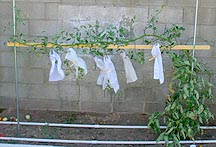
The strings of fruit (protected from birds above by being wrapped in handkerchiefs) hang down clear of the plant for easy picking. Several plants can be stacked with their trunks a foot or so above each other.
My
Fertilizing Technique:
I admit to being obsessive about making sure that each plant gets its share of fertilizer. I used to control this by building earth berms around each plant to hold the fertilizer solution in. The problems with this technique are that the distribution within the berm isn't always even and maintaining the berms is a hassle.
My solution is to use four, 1-gallon containers with very small holes drilled in their bottoms to let the fertilizer solution seep out slowly enough so that it doesn't drain away.

Ringing each plant in turn and filling the containers with fertilizer solution ensures that the each plant gets all the fertilizer it's supposed to and that the solution soaks in deeply and evenly.
Each tomato plant receives four tablespoons of 18-18-21 Miracle Grow Tomato food dissolved in four gallons of water once a week. This is in addition to working enormous amounts of organic matter (shredded leaves, bone meal, blood meal and alfalfa meal) deep into the soil during the off time of year. I endorse the benefits of organic gardening but use some chemicals to boost the plants to their greatest potential. The soil in my beds is dark, rich, crumbly, absorbs and holds water like a sponge yet is free-draining, and teems with earthworms. Once every two or three years I measure the soil's acidity and mix in peat moss to correct its tendency toward turning alkaline.
Beefsteak Tomato Comparisons
I only started testing beefsteak tomatoes during the current season. As such I have few results to present, but I hope you'll find what there is helpful. Because beefsteak tomatoes are about flavor rather than sweetness or acidity, I won't be measuring those two quantities but instead be relying on taste tests.
Sweet Tangerine: Three-inch diameter orange fruits with a flavor that's so mild and bland that it didn't rate very high with the taste testers.
Burpee's Steak Sandwich: Four-inch diameter fruits are thick and meaty with a deeply hearty flavor that all the testers relished.
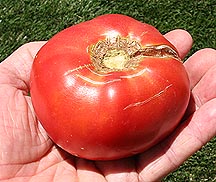
Burpee's Steaksandwich tomato
tends to crack near the stem
but that doesn't effect its great flavor.
Burpee's
Big Boy: Attractive, 3-inch
fruits that had an average tomato flavor. There tended to be an awful
lot of loose seeds, watery juice and less than average quantities of meat.
Burpee's Super Tasty: Orange-red 4-inch fruits have a pleasant, rich flavor that though very good, isn't as hearty and delicious as Steak Sandwich. Super tasty cracks very badly.
2008
Selections:
This year's tomato season started February 12 when I seeded 20 pots with 14 different varieties of full sized tomatoes. Shortly after the plants emerged I noticed the leaves were an unhealthy yellow and growth was weak and spindly. By the 6th week the plants were starting to die. What had happened was that I had sterilized the potting soil in the oven and it seemed to change the ph of the soil, which locked up nutrients so the plants couldn't absorb them. I tried a variety of fertilizers and micronutrient suppliments but nothing helped. I lost them all.
By this time it was mid April and too late to get more seeds to start another set of transplants. Rather than skip an entire season I decided to raid the local Walmart for every variety they had and see how they performed. Here's what I got:
Pink
Brandywine
Mr.
Stripey
Celebrity
Beefmaster
Big
Beef
Golden
Jubilee
Red
Beefsteak
Park's
Whopper
Early
Girl
Better
Boy
German
Queen
One of the hazards of purchasing transplants with generic names like Beefmaster and Red Beefsteak is that there is no way of knowing if these are the actual variety names or "up market" names used to attract customers. I wouldn't be surprised if some transplant companies sell the same variety under several different names. The tomatoes are presented in the order they ripened.
I also have two Steak Sandwich and two of the great Japanese tomato Momotaros to act as standards to compare the others to. These were grow from seed and were later than the transplants. The first fruits from the purchased transplants ripened in late June.
Beefmaster:
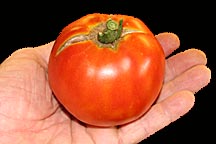
A great tasting tomato with a rich, hearty flavor. The three-inch fruits are light red or dark orange with irregular yellowish zones. Beefmaster tends to crack. The meat is very solid making it an outstanding slicer. However, even with all these great attributes Steak Sandwich is even richer, heartier, larger and meatier.
Park's
Whopper:
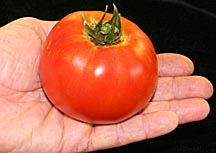
While
the flesh was solid with very little juice the flavor was weak and
watery. This is surprising because I expected better from a product
that carries the company name.
Red
Beefsteak:
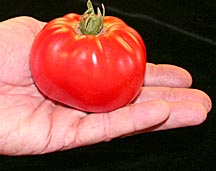
A pure red tomato with solid flesh and a deep, rich, hearty flavor similar if not identical to Beefmaster. Cracks less than Beefmaster making it the preferred choice.
Better
Boy:
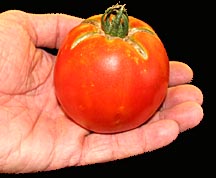
Average size fruit with average flavor. Not bad but there are many other varieties that are much better.
German
Queen:
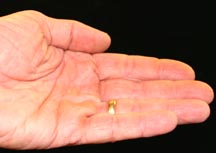
No, I didn't forget the fruit... there weren't any. Although the plant was a healthy, vigorous grower and tomato plants on either side of it produced fruit not one single flower of the many dozens this plant set produced a tomato. The flowers behaved normaly but after closing instead of starting a tiny tomato they just fell off the stem. I'm sure someone gets tomatoes off this variety but I didn't so I can't recommend it.
Golden
Jubilee:
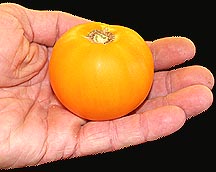
Attractive, though smallish, fruits with a distinctly sour flavor.
Early
Girl:

Another small type with a pure red color. The flavor was hearty but not sweet enough.
Big
Beef:
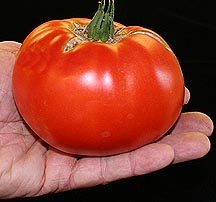
A big, beautiful tomato with good flavor, but once again, Steak Sandwich's superior taste beats it hands down. Side-by-side comparisons rank Big Beef better than Red Beefsteak and Beefmaster.
Pink
Brandywine:
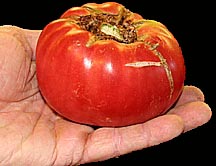
We found this popular heirloom sour and unattractive because of the large stem scar.
Arkansas Traveler:

Arkansas Traveler produced small, flavorless tomatoes that were sour.
Mr.
Stripey:
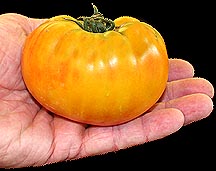
This variety had a watery flavor that wasn't sweet enough. The fruit is yellow with orange blotches, not very attractive.
Celebrity:

Celebrity ripens almost all of its fruit at the same time, great for short season areas. We found its flavor inferior to Steak Sandwich and Big Beef.
Momotaro:

Although advertised as being crack resistant, all of mine cracked. The flavor was sour compared to Big Beef.
Off-The-Vine
Ripening Experiment
I've read that a green tomato can be ripened by placing it under a bowl with a banana. The banana gives off ethylene gas as it ripens and this gas forces the tomato to ripen. The image below shows a tomato picked green and ripened in this manner:
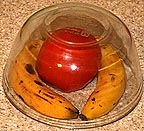
It looked okay but this Big Beef, which is delicious ripened on the vine, was horrible ripened artificially. In my opinion it's better to go without tomatoes than eat an artificially ripened one.
Having said this, I acknowledge that 99-percent of supermarket tomatoes are artificially ripened and while they don't taste great, they are tolerable. I don't know how they do it but I doubt it involves bananas.
Conclusions:
The final verdict for the 2008 season was the Sun Gold still rules as the supreme cherry tomato and that Steak Sandwich and Big Beef tie as the best beefsteak. Steak Sandwich can have better flavor, but Big Beef produces larger, more attractive fruit that top Steak Sandwich in the flavor department when the weather gets into the high 90s. Big Beef is also more resistant to blossom end rot, is more productive and more crack resistant.
I'm sure there are better tasting tomatoes than Steak Sandwich and Big Beef, but instead of testing more varieties next year I plan to invest my time figuring out how to improve the quality of these two great tomatoes. In particular, I want to develop a foolproof technique for determining beefsteak ripeness before picking.
Until next year... I wish you great gardening!
2010 Test!
The 2010 season is limieted to just one variety, a new orange cherry tomato release by Parks named Paruche.
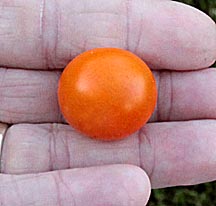
It's flavor was sweet and mild with low acid. It lacked the bright fruity notes that make Sun Gold a winner so this isn't one we'll be planting again.
2013 Test - Park's Nectar Tomato: A Real Winner!!!
The Park Seed Company has released a large cherry tomato named Nectar and I'm happy to report that it is absolutely the sweetest, lowest acid tomato of any kind I've ever grown.
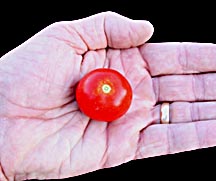
Nectar tomatoes average 1.25 inches in diameter so they rank on the large end of the cherry tomato size range. They resist cracking (none of the many dozens I've picked have shown the least indication of doing so) are perfectly spherical, a deep, attractive red with just a hint of orange and overall the most attractive tomato I've ever seen. When I had my tasters try them their reactions were all the same: their eyes open wide with delight like a child's on Christmas morning. While they rave about how sweet Nectar tomatoes are, they also say these fruits are richly and deeply flavored. And the numbers? Would you believe my refractometer measured a whopping 10.1-percent sugar? This is as high as most muskmelons (improperly labeled as cantaloupes) in supermarkets. Also, the boundary line marking the sugar level was very wide, indicative of many flavor components. The PH measured 4.7, the highest I've ever seen in a tomato, which means it has the lowest acidity. These two factors combine to make it the sweetest tomato I've ever tested.
The Park Seed Company has come up with a real winner in the Nectar tomato. I encourage tomato lovers everywhere to give this one a try! For myself I've switching exclusively to growing this great new variety.
2014 Test - Sweet Aparatif
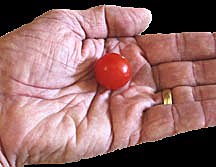
This
very small cherry tomato isn't as sweet, flavorful, or productive as Nectar.
Attack of the Nematodes!
In 2007 I noticed that a late planting seemed to slow down considerably before they should. When I dug the plants up I discovered why: Nematodes
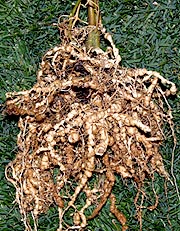
These microscopic worms burrow into the roots of plants, creating colonies that cause lumpy growths on the roots and restrict the plant's ability to collect nutrients and water.

While there are chemical soil treatments that'll eliminate them and other more organically friendly options, I decided to use SOLARIZATION to test how effective that technique is. I solarized the soil during the 2007-2008 winter using the electric heating cable technique. When I dug up tomato plants grown in the nematode-infested area in the summer of 2008 the roots were completely free of the swollen nodules indicative of nematode infestation. From this I conclude this solarization technique worked... at least for one season. The following year the nematodes were back with a vengeance.
HYDROPONIC TOMATOES!
Faced with unsolvable problem of nematodes, I decided to give hydroponics a try. Not only did it work, but it solved both cracking and dehydration problems. The following short video shows what's going on in the start of the 2016 season:
(Click
on main site
to browse 70 other topics ranging from exotic kaleidoscope designs to
the strange world of lucid dreaming.)